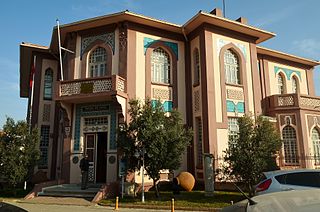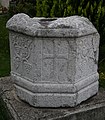
The National Museum of Aleppo is the largest museum in the city of Aleppo, Syria, and was founded in 1931. It is located in the heart of the northern city on Baron Street, adjacent to the famous Baron Hotel and near the Bab al-Faraj Square and Clock Tower. The majority of the museum's exhibitions are devoted to the archaeology of Syria, with most of the finds coming from archaeological sites of the northern part of the country.

Tarsus Museum is an archaeology and ethnography museum in Tarsus, Mersin Province, in southern Turkey.

Tekirdağ Museum of Archaeology and Ethnography, shortly Tekirdağ Museum, is a national museum in Tekirdağ, Turkey, exhibiting archaeological artifacts found in and around the province, as well as ethnographical items related to the region's cultural history.

The Afyonkarahisar Archaeological Museum, also known as the Afyon Museum, is an archaeological museum in Afyonkarahisar, Turkey. It exhibits a wide variety of artifacts from the Copper Age, Bronze Age and the civilizations of Hittites, Phrygians, Ancient Greece and the Byzantine Empire.

Alanya Archaeological Museum is an archaeological museum in Alanya, Turkey. The museum is divided into two sections, with displays of archaeological and ethnographic artifacts. It contains numerous ceramic, marble, bronze and glass pieces and mosaics from the Hellenistic, Roman, and Byzantine periods. Of particular note is its 2nd century bronze statue of Hercules, which measures 52 centimetres (20 in) in height. The museum, which was established in 1967, was refurbished in 2012.

Aydın Archaeological Museum is in Aydın, western Turkey. Established in 1959, it contains numerous statues, tombs, columns and stone carvings from the Hellenistic, Roman, Byzantine, Seljuk and Ottoman periods, unearthed in ancient cities such as Alinda, Alabanda, Amyzon, Harpasa, Magnesia on the Maeander, Mastaura, Myus, Nisa, Orthosia, Piginda, Pygela and Tralleis. The museum also has a section devoted to ancient coin finds.

Sinop Archaeological Museum, or Sinop Museum, is a national museum in Sinop, Turkey, exhibiting archaeological artifacts found in and around the city.

Konya Ereğli Museum is an archaeological and ethnographic museum in Ereğli district of Konya Province, Turkey. Situated in the İstasyon cad, it is operated by the Ministry of Culture and Tourism.
Amasya Museum, also known as Archaeological Museum of Amasya, is a national museum in Amasya, northern Turkey, exhibiting archaeological artifacts found in and around the city as well as ethnographic items related to the region's history of cultural life. Established in 1958, the museum owns nearly twenty-four thousand items for exhibition belonging to eleven historic civilizations.

Amasra Museum is a museum in Amasra district of Bartın Province, northwestern Turkey. Established in 1982, it exhibits archaeological artifacts and ethnographic items.
Ödemiş Museum is a museum in Ödemiş ilçe (district) of İzmir Province, Turkey. It is on Turkish state highway 310 situated slightly to the east of the town centre.
Bilecik Museum is a museum in Bilecik, Turkey.

Eskişehir Eti Archaeology Museum, a.k.a. Eskişehir Archaeology Museum, is a national archaeology museum in Eskişehir, Turkey. It was established in 1974.
Isparta Museum is a museum in Isparta, Turkey. It is on Millet street in Isparta at 37°46′15″N30°33′30″E.

Nevşehir Museum is in Nevşehir, Turkey
Elazığ Archaeology and Ethnography Museum is a museum in Elazığ, Turkey
Karadeniz Ereğli Museum is a museum in Ereğli ilçe (district) of Zonguldak Province, Turkey. The modifier Karadeniz is used to distinguish Ereğli in Zonguldak Province from another similar-named ilçes in Konya and Tekirdağ Provinces.
Kilis Museum is a museum in Kilis, Turkey

Kayseri Archaeology Museum is a museum in Kayseri, Turkey. Kayseri Archeology Museum, which has been serving here for about 50 years, has been moved to the new museum building within the Kayseri Castle and has been opened to visitors since 19 October 2019. In the new museum, there are 14 exhibition halls in chronological order. The works in the exhibition halls date from the Chalcolithic Age to the Late Osmanlı period. The address now is Cumhuriyet Mahallesi, Kaleiçi Meydan Kümeevler, No: 1, Melikgazi/Kayseri.

Mardin Museum is a museum in Mardin, Turkey

























